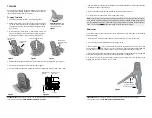
HEADQUARTERS: Anderson Power Products®, 13 Pratts Junction Road, Sterling, MA 01564-2305 USA
T:978-422-3600 F:978-422-3700
www.andersonpower.com
HEADQUARTERS: Anderson Power Products®, 13 Pratts Junction Road, Sterling, MA 01564-2305 USA
T:978-422-3600 F:978-422-3700
www.andersonpower.com
Figure 5
Figure 5a
OPERATION
Open the tool by squeezing the handles together. At the end of the
closing stroke, the ratchet mechanism will release the handles and
the hand tool will spring open. (See Figure 1)
Crimping Terminals
1. Select the desired terminal listed in the preceding charts.
2. Handles of the tools must be in the fully open position as in Figure
1. With the locator attached, push the locator button on the back
of the hand tool to bring the locator forward through the tooling.
(See Figure 2)
3. While holding the locator button in, load the terminal into the
proper nest opening in the locator based on the wire gauge or
terminal type markings on the hand tooling. (See Figure 3)
7. Crimp the terminal by squeezing the tool handles until the ratchet mechanism cycle has been completed.
Release the handles to open the jaws.
8. Remove the crimped terminal from the terminal locator by pulling on the wire.
9. Visually inspect the crimped terminal for proper crimp location.
Ratcheting Handle Squeeze
handles together and release
handle will spring open
Figure 1
4. Release the locator button, allowing the locator to return to the crimping position. (See Figure 4)
5. Close the tool handle until the first ratchet position engages.
6. Insert the properly stripped wire through the terminal and against the wire stop. (See Figure 5 & 5a)
Figure 2
Figure 3
Figure 4
Maintenance
It is recommended that each operator of the tool be made aware of, and responsible for, the following
maintenance steps:
1. Remove dust, moisture, and other contaminants with a clean brush, or soft, lint free cloth.
2. Do not use any abrasive materials that could damage the tool.
3. Make certain all pins; pivot points and bearing surfaces are protected with a thin coat of high
quality machine oil (See Figure 6). Do not oil excessively. Light oil (such as 30 weight automotive
oil) used at the oil points, every 5,000 crimps or 3 months, will significantly enhance the tool life.
4. Wipe excess oil from hand tool, particularly from crimping area. Oil transferred from the crimping area
onto certain terminations may affect the electrical characteristics of an application.
5. When tool is not in use, keep the handles closed to prevent objects from becoming lodged in the
crimping dies, and store the tool in a clean, dry area.
Wire stop is part
of the locator
Wire against the
wire stop
Wire
Terminal
Note: A crimp height chart is provided with this manual as Reference Only. Due to the wide range of
wires, strands, insulation diameters, and durometers available, actual crimp height measurements
may vary slightly. An occasional, destructive, pull force test should be performed to check hand tool
crimp. Pull Force value Must exceed the minimum pull force specifications listed.
Lubrication Points
(use a light oil every 3
months or 5,000 crimps)
Figure 6
Release locator
button with contact
inserted
Terminal loaded into locator
Locator Pushed
thru tool
Locator button
pushed in




















